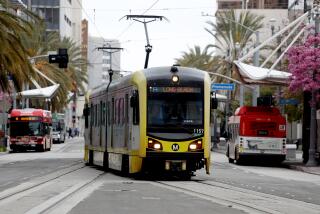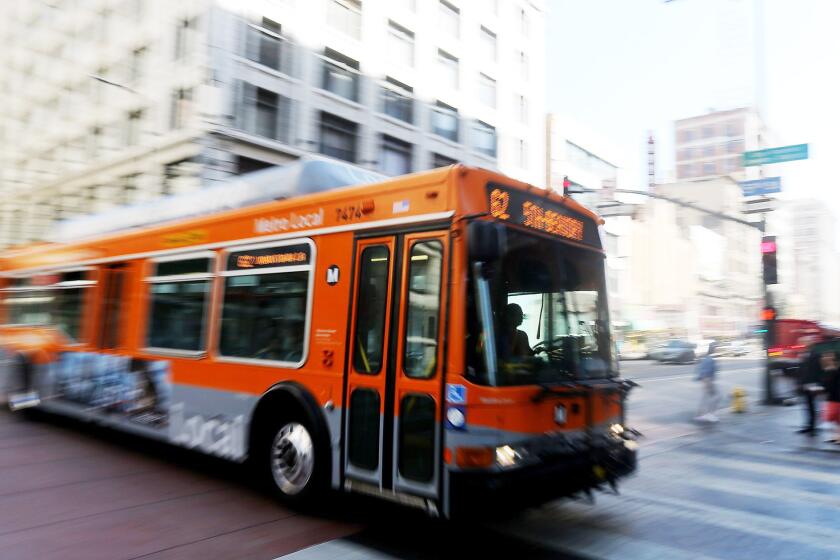MTA prepares for a rail-car reality check
- Share via
On Thursday, barring some unforeseen event, one of the county’s longest-running public soap operas will come to an end when the Metropolitan Transportation Authority’s board decides whether or not to extend an Italian company’s contract to build light-rail cars for the Gold and Expo lines.
AnsaldoBreda is a division of the Italian-based Finmeccanica conglomerate and manufactures and assembles rolling stock for rail systems around the world. It’s midway through a contract to build 50 cars for the L.A. transit agency and would like to see the agreement extended to include 100 more, a job worth $300 million. The problem is that the company is, by some estimates, three years behind in its delivery of the cars, and those that have arrived are 6,000 pounds overweight and incompatible with the MTA’s other light rail, though the agency has agreed to waive the latter requirement.
The company blames the transit agency’s change orders for the problems; the MTA says AnsaldoBreda just can’t deliver the promised coaches on time and in acceptable shape. Thus the agency’s CEO, Art Leahy -- like his predecessor, Roger Snoble -- wants the board to put the contract for the next 100 cars out for bid. To forestall that, AnsaldoBreda is offering a variety of financial incentives it says amount to about $400 million to guarantee its performance.
More important, it proposes to build what its designated construction partner, Shangri-La, calls “a state-of-the-art, solar-powered rail car assembly and manufacturing facility at the [Los Angeles] Community Redevelopment Agency’s Clean Tech Manufacturing center in downtown L.A.” In fact, AnsaldoBreda already has reached an agreement with the CRA -- contingent on winning the MTA contract -- to take a 50-year lease on 14 acres of the old industrial tract at 15th and Washington that Mayor Antonio Villaraigosa hopes to turn into a green manufacturing zone. The tentative deal calls for a $15-million payment up front and $906,000 in annual rent, with periodic reappraisals. (Shangri-La, an environmentally focused construction company, is owned by billionaire Steve Bing, a leading Villaraigosa ally and financial contributor.)
Fights over major public manufacturing and construction contracts often are conducted under rules that make bare-knuckle prizefighting seem effete. Even by those standards, this one has been a bitter brawl. The latest twist involves charges by the AnsaldoBreda camp that one of its potential rivals for the contract -- Germany’s Siemens -- has profited by providing Iran with the technical wherewithal to spy on its people. The Italian firm’s critics have pointed out in response that one of AnsaldoBreda’s sister companies has built gas turbines that power more than 30% of the Iranian grid. The fact of the matter is that the charge and countercharge are both tuna-sized red herrings.
Neither the chilling specter of a nuclear-armed Iran nor the mullah-ridden theocracy’s brutal repression of its brave people will be lifted one inch by anything the MTA’s board does.
What’s vexing about the decision the board confronts is that the criteria for sound decision-making are being scrambled by the Wall Street meltdown, growing concern about climate change and the need for energy independence.
There are two ways of looking at the light-rail decision:
One relies on the well-tested and hardheaded view that a contract is a contract and its terms must be met letter for letter, particularly when there’s public money involved. There is, moreover, reason to be skeptical of AnsaldoBreda’s financial guarantees and its promises to clean up its act, given the economic vagaries of the time. Finally, federal law forbids making local manufacture a condition for awarding transit contracts.
The other view is that a great deal has changed since the start of the worst financial downturn since the Depression. A study funded by the County Federation of Labor estimates that the proposed $70-million plant in downtown would directly employ more than 500 blue-collar workers and more than 100 corporate staff -- with hundreds of ancillary jobs. The survey projected that 970 construction workers would be required to build the plant. All these would be union jobs, paying decent wages with real benefits.
Even if you discount for the federation’s enthusiasm -- and its optimistic forecast that the plant would build 75 new cars annually and refurbish another 36 -- that’s no small thing in a city where the real unemployment rate is probably around 15% and heading higher. Finally, building as much of our transit system’s rolling stock as possible in L.A. would help keep more of the Measure R tax money funding the projects inside the county.
The Italian firm knows it has more than 100 light-rail cars at stake here; Los Angeles will be a rail construction mecca for decades to come, and AnsaldoBreda hopes to use the local plant to take a major share of that business, including the California and Las Vegas high-speed rail lines.
The MTA’s professional staff isn’t free to take these sorts of political and economic factors into consideration, but the elected officials who make up the board may not be free to ignore them. The choice isn’t a clear one. It is, as they say, a very close question.
Welcome to the recession-honed horns of local government’s new dilemma.
--
More to Read
Sign up for Essential California
The most important California stories and recommendations in your inbox every morning.
You may occasionally receive promotional content from the Los Angeles Times.










